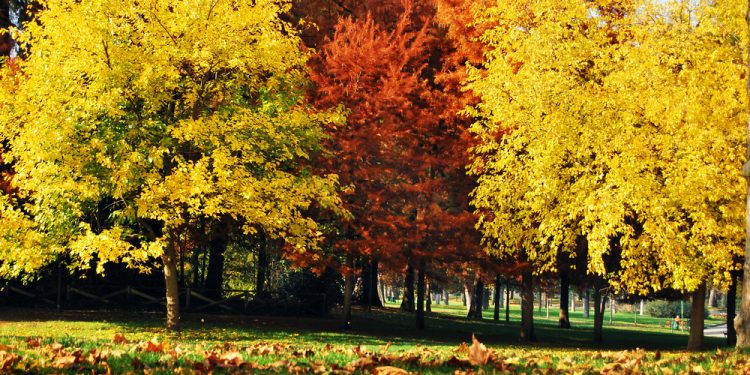
Autumnal Equinox
The Autumnal Equinox, also known as the September Equinox in the Northern Hemisphere, begins on the day when the sun appears to cross the celestial equator and heads southward. This can occur anytime between September 21st and September 24th due to the differences inherent between the tropical year and the calendar year.
The sun, viewed from the equator on the equinox, rises due east and sets due west. It marks the end of the astronomical summer in the Northern Hemisphere and the start of the astronomical spring in the Southern Hemisphere.
Although the Autumnal Equinox begins in September in the Northern Hemisphere, it actually begins in March in the Southern Hemisphere and is known as the March Equinox in that part of the world.
The Autumnal Equinox has historically, and is currently, an important holiday for agriculturally based communities. It’s a day that’s usually observed with some type of fall festival or gathering. For many religions, the Autumnal Equinox also has spiritual significance.
In Greek mythology, it’s linked to Persephone returning to the underworld to become the wife of Hades, the god of the dead. While she’s in the land of the dead, her mother Demeter refuses to let the plants grow – which is the Ancient Greek explanation for the winter season.
In various Neopagan religions, it is the day of Mabon that encourages participants to reap what they sow – not only in a literal sense but also in a figurative sense as well. Although there are no current Christian holidays that fall on the Autumnal Equinox, it’s believed that Michaelmas was originally created to divert pagans from their celebrations at this time of the year.
We Have Solstices & Equinoxes Because Of The Earth’s Tilt
The reason we have equinoxes (and solstices, too) is because of the Earth’s tilt. The Earth has an axial tilt of 23.4 degrees, which means that there’s a mismatch between the Northern and Southern Hemispheres. Below is a list of the two equinoxes and two solstices as experienced by both the Northern and Southern Hemispheres.
March Equinox
- In the Northern Hemisphere, it’s the first day of spring and is, therefore, the Spring (or Vernal) Equinox.
- In the Southern Hemisphere, it’s the first day of fall and is, therefore, the Fall (or Autumn) Equinox.
June Solstice
- In the Northern Hemisphere, it marks the first day of summer and is therefore known as the Summer Solstice.
- In the Southern Hemisphere, it marks the first day of winter and is therefore known as the Winter Solstice.
September Equinox
- In the Northern Hemisphere, it marks the first day of fall and is therefore known as the Autumnal (or Fall) Equinox.
- In the Southern Hemisphere, it marks the first day of spring and is therefore known as the Spring (or Vernal) Equinox.
December Solstice
- In the Northern Hemisphere, it marks the first day of winter and is therefore known as the Winter Solstice.
- In the Southern Hemisphere, it marks the first day of summer and is therefore known as the Summer Solstice.
Autumnal Equinox Customs, Traditions & Observations
Ohigan
The Autumnal Equinox is celebrated in different ways all over the world. In Japan, both the September and March equinoxes mark a period known as Ohigan. It’s observed because, in Japanese Buddhist belief, the land of the afterlife is west, so during this time when the sun sets directly west, it’s a time that’s symbolic of life’s transitions.
It’s a holiday that’s not only observed in Japan but is observed among the Japanese diaspora all over the world. This is a time when people visit the graves of their ancestors, clean up and care for their gravesites, and leave flowers.
Ohigan is observed for 7 days for the Vernal Equinox and 7 days for the Autumnal Equinox. This celebration begins 3 days before each equinox. This is also the time when the flowers called Higanbana bloom.
These flowers are known as Ghost Flowers or Dead Flowers because they bloom around some graveyards in Japan during this time. The scientific name for this flower is Lycoris radiata, and it’s a plant that is in the plant family Amaryllidaceae. It’s also known as the Red Spider Lily.
The Mid-Autumn Festival
Another holiday that falls around the Autumnal Equinox, and may begin on the actual day of the equinox depending on the year, is the Mid-Autumn Festival. This festival is held on the 15th day of the 8th month of the Chinese lunisolar calendar.
This places it somewhere between mid-September and early October on the Gregorian calendar. This is a time when the Chinese believe that the autumn moon is at its brightest and it coincides with the harvest. This is a day when people light lanterns, engage in moon worship, and eat mooncakes.
In Pagan & Neopagan Celebrations
Pagan mythology divides the year into one of eight important holidays. These holidays include Yule celebrated December 20-23rd, Imbolc celebrated February 2nd, Ostara celebrated between March 19-22nd, Beltane on May 1st, Midsummer celebrated on June 19-23rd, Lughnasadh observed on August 1st, Mabon on September 21 through 24th, and Samhain on October 31-November 1st.
Each of these important times has its own rituals and celebrations associated with them. The Autumnal Equinox is known as the Second Harvest or Mabon. This is a time when people give their thanks for the summer and pay tribute to the coming of winter.
Many of the rituals for Mabon include gathering and eating apples, offering apples to the goddess, sharing food with friends and neighbors, giving thanks for one’s blessings, and building altars composed of harvested vegetables and fruits.
It’s also a time to prepare for the coming of Samhain. Samhain is a Gaelic festival that marks the beginning of winter and the end of the harvest season.
Stonehenge Autumnal Equinox Celebrations
Every year on the Autumnal Equinox, pagans, druids, and tourists gather for the ad hoc celebration that occurs at Stonehenge every year. For pagans, druids, and Wiccans, it’s a spiritual event that can have a profound effect on their worldview.
The Catholic Feast Of Michaelmas
Although Michaelmas isn’t an Autumnal Equinox observation, it does fall around this time, so it’s worth mentioning. It’s also worth including because many historians believe that Michaelmas was created to draw people away from pagan autumn festivals towards this Christian-centric holiday.
Michaelmas is observed after the equinox, and people gather nuts and eat nuts during this time, as well as eat a large celebratory meal.
Non-Religious Observations
Of course, the Autumnal Equinox isn’t just celebrated for religious reasons. It’s also observed by people who simply want to enjoy the first day of fall. In some areas of the United States and Europe, there may be fairs and harvest festivals on this day.
It’s also a time when people are preparing their homes for Halloween, so people can expect to see either spooky-themed decorations or harvest-themed decorations in or around their homes.
The harvest festival decorative theme is carried through Halloween and all the way to Thanksgiving in the U.S., when decorations finally change to more of a Christmas theme. The Autumnal Equinox has transitioned away from being a holiday that celebrates the harvest and more like a day on which people can reflect on the holidays yet to come.








